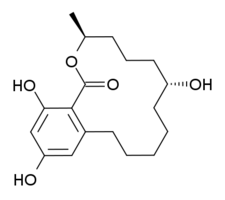Zeranol
 | |
| Clinical data | |
|---|---|
| Trade names | Frideron, Ralabol, Ralgro, Ralone, Zerano |
| Synonyms | Zearanol; α-Zearalanol; Zearalanol; MK-188; P-1496 |
| Routes of administration | By mouth |
| Drug class | Nonsteroidal estrogen |
| Identifiers | |
IUPAC name
| |
| CAS Number |
|
PubChem CID |
|
| ChemSpider |
|
| UNII |
|
| ChEMBL |
|
| ECHA InfoCard | 100.043.411 |
| Chemical and physical data | |
| Formula | C18H26O5 |
| Molar mass | 322.40 g·mol−1 |
| 3D model (JSmol) |
|
SMILES
| |
InChI
| |
.mw-parser-output .nobold{font-weight:normal} (verify) | |
Zeranol (INN, USAN, BAN) (brand names Frideron, Ralabol, Ralgro, Ralone, Zerano; developmental code names MK-188, P-1496), or zearanol, also known as α-zearalanol or simply zearalanol, is a synthetic nonsteroidal estrogen of the resorcylic acid lactone group related to mycoestrogens found in fungi in the Fusarium genus and is used mainly as an anabolic agent in veterinary medicine.[1][2][3]
Zeranol is approved for use as a growth promoter in livestock, including beef cattle, under the brand name Ralgro (by Merck Animal Health) in the United States.[4] In Canada, it is approved for use in beef cattle only.[5] Its application is not approved for use in the European Union. However, it is marketed under the brand name Ralone in Spain.[2]
Although zeranol may increase cancer cell proliferation in already existing breast cancer,[6] dietary exposure from the use of zeranol-containing implants in cattle is insignificant by some scholars.[7] Zeranol may be found as a contaminant in fungus-infected crops. It is 3 to 4 times more potent as an estrogen than the related compound zearalenone.[8]
See also
- α-Zearalenol
- β-Zearalenol
- Taleranol
- Zearalanone
- Beef hormone controversy
References
^ J. Elks (14 November 2014). The Dictionary of Drugs: Chemical Data: Chemical Data, Structures and Bibliographies. Springer. pp. 350–. ISBN 978-1-4757-2085-3..mw-parser-output cite.citation{font-style:inherit}.mw-parser-output q{quotes:"""""""'""'"}.mw-parser-output code.cs1-code{color:inherit;background:inherit;border:inherit;padding:inherit}.mw-parser-output .cs1-lock-free a{background:url("//upload.wikimedia.org/wikipedia/commons/thumb/6/65/Lock-green.svg/9px-Lock-green.svg.png")no-repeat;background-position:right .1em center}.mw-parser-output .cs1-lock-limited a,.mw-parser-output .cs1-lock-registration a{background:url("//upload.wikimedia.org/wikipedia/commons/thumb/d/d6/Lock-gray-alt-2.svg/9px-Lock-gray-alt-2.svg.png")no-repeat;background-position:right .1em center}.mw-parser-output .cs1-lock-subscription a{background:url("//upload.wikimedia.org/wikipedia/commons/thumb/a/aa/Lock-red-alt-2.svg/9px-Lock-red-alt-2.svg.png")no-repeat;background-position:right .1em center}.mw-parser-output .cs1-subscription,.mw-parser-output .cs1-registration{color:#555}.mw-parser-output .cs1-subscription span,.mw-parser-output .cs1-registration span{border-bottom:1px dotted;cursor:help}.mw-parser-output .cs1-hidden-error{display:none;font-size:100%}.mw-parser-output .cs1-visible-error{font-size:100%}.mw-parser-output .cs1-subscription,.mw-parser-output .cs1-registration,.mw-parser-output .cs1-format{font-size:95%}.mw-parser-output .cs1-kern-left,.mw-parser-output .cs1-kern-wl-left{padding-left:0.2em}.mw-parser-output .cs1-kern-right,.mw-parser-output .cs1-kern-wl-right{padding-right:0.2em}
^ ab Index Nominum 2000: International Drug Directory. Taylor & Francis. January 2000. pp. 1105–. ISBN 978-3-88763-075-1.
^ I.K. Morton; Judith M. Hall (6 December 2012). Concise Dictionary of Pharmacological Agents: Properties and Synonyms. Springer Science & Business Media. pp. 295–. ISBN 978-94-011-4439-1.
^ Nichols, Wade; Hutcheson, John; Streeter, Marshall; Corrigan, Mark; Nuttelman, Brandon. "Implant Strategies for Finishing Cattle using Revalor® (trenbolone acetate and estradiol), Finaplix® (trenbolone) and/or Ralgro® (zeranol)" (PDF). Merck Animal Health.
^ Health Canada, Questions and Answers - Hormonal Growth Promoters
^ Xu, Pingping; Ye, Weiping; Jen, Robert; Lin, Shu-Hong; Kuo, Chieh-Ti; Lin, Young C. (2009-11-01). "Mitogenic activity of zeranol in human breast cancer cells is enhanced by leptin and suppressed by gossypol". Anticancer Research. 29 (11): 4621–4628. ISSN 1791-7530. PMID 20032412.
^ Lindsay DG (August 1985). "Zeranol--a 'nature-identical' oestrogen?". Food Chem Toxicol. 23 (8): 767–74. PMID 2931335.
^ Mirocha, CJ; Schauerhamer, B; Christensen, CM; Niku-Paavola, ML; Nummi, M (1979). "Incidence of zearalenol (Fusarium mycotoxin) in animal feed". Applied and Environmental Microbiology. 38 (4): 749–50. PMC 243572. PMID 161492.